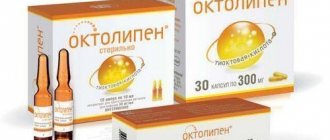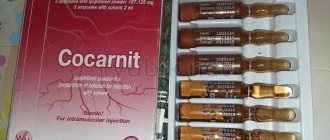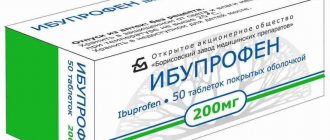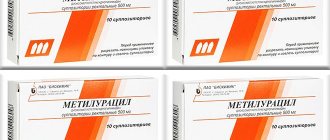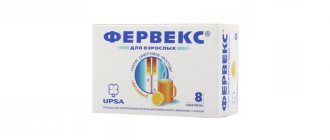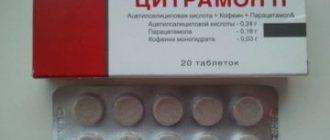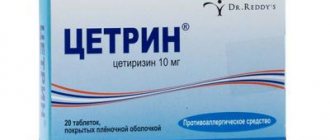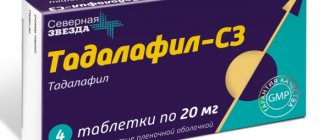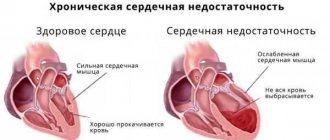A medicine belonging to the group of broad-spectrum penicillin antibiotics is Ampicillin. Instructions for use prescribe taking 250 mg tablets, powder for preparing a suspension, injections in ampoules for injections for infectious pathologies. According to doctors, this drug helps in the treatment of sore throat and other infectious diseases.
Release form and composition
Ampicillin is available in the following dosage forms:
- The tablets are white and flat-cylindrical in shape. Sold in blisters of 10 pieces. 1 package contains 1 or 2 blisters.
- Powder for the preparation of suspension for oral administration. It has a white-yellowish tint. Sold in bottles. The kit includes a dosing spoon.
- Lyophilisate for preparing a solution for intramuscular and intravenous administration. Sold in bottles of 10 or 20 ml. 1 pack contains 1, 5, 10 or 50 bottles.
Compound
- 1 tablet of ampicillin trihydrate contains 0.25 g. Potato starch, talc, croscarmellose sodium, calcium stearate as excipients.
- 1 capsule of ampicillin trihydrate contains 0.25 g. Potato starch and powdered sugar.
- In 1 bottle of ampicillin sodium 0.25 g, 0.5 g, 1 g and 2 g.
- 5 ml of ampicillin trihydrate suspension 12.5 g and 0.25 g. Sugar, food flavoring.
pharmachologic effect
Ampicillin is one of the antibiotics belonging to the group of semisynthetic broad-spectrum penicillins. Its bactericidal effect is manifested by suppressing the synthesis of bacterial cell walls.
The drug is effective against gram-positive aerobic bacteria (Staphylococcus spp., Listeria monocytogenes and Streptococcus spp.), gram-negative aerobic bacteria (Escherichia coli, Shigella spp., Neisseria gonorrhoeae, Bordetella pertussis, Salmonella spp., Neisseria meningitidis), and some strains of Haemophilus influenzae.
AMPICILLIN
Drug: AMPICILLIN Active substance: ampicillin ATC code: J01CA01 KFG: Broad-spectrum penicillin antibiotic, destroyed by penicillinase Reg. number: P No. 011643/02 Registration date: 03/20/08 Owner of reg. ID: HEMOFARM KONCERN AD {Yugoslavia}
DOSAGE FORM, COMPOSITION AND PACKAGING
| Granules for preparation of suspension for oral administration | 5 ml of ready-made suspension. |
| ampicillin (in trihydrate form) | 250 mg |
40 g - 100 ml bottles (1) - cardboard packs.
DESCRIPTION OF THE ACTIVE SUBSTANCE. The scientific information provided is general and cannot be used to make a decision about the possibility of using a particular drug.
PHARMACHOLOGIC EFFECT
An antibiotic from the group of semisynthetic penicillins with a broad spectrum of action. It has a bactericidal effect by inhibiting the synthesis of bacterial cell walls.
Active against aerobic gram-positive bacteria: Staphylococcus spp. (except for penicillinase-producing strains), Streptococcus spp., Enterococcus spp., Listeria monocytogenes; aerobic gram-negative bacteria: Neisseria gonorrhoeae, Neisseria meningitidis, Escherichia coli, Shigella spp., Salmonella spp., Bordetella pertussis, some strains of Haemophilus influenzae.
Ampicillin is destroyed by penicillinase. Acid resistant.
PHARMACOKINETICS
After oral administration, it is well absorbed from the gastrointestinal tract. Ampicillin is distributed in most organs and tissues. Penetrates the placental barrier, poorly penetrates the BBB. With inflammation of the meninges, the permeability of the BBB increases sharply. 30% of ampicillin is metabolized in the liver. Excreted in urine and bile.
INDICATIONS
Infectious and inflammatory diseases caused by microorganisms sensitive to ampicillin: incl. infections of the ear, throat, nose, odontogenic infections, bronchopulmonary infections, acute and chronic urinary tract infections, gastrointestinal infections (including salmonellosis, cholecystitis), gynecological infections, meningitis, endocarditis, septicemia, sepsis, rheumatism, erysipelas, scarlet fever, skin and soft tissue infections.
DOSING REGIME
They are set individually depending on the severity of the disease, the location of the infection and the sensitivity of the pathogen.
When taken orally for adults, the single dose is 250-500 mg, the frequency of administration is 4 times a day. Children weighing up to 20 kg - 12.5-25 mg/kg every 6 hours.
For intramuscular, intravenous administration, a single dose for adults is 250-500 mg every 4-6 hours. For children, a single dose is 25-50 mg/kg.
The duration of treatment depends on the location of the infection and the characteristics of the course of the disease.
Maximum daily dose: for adults when taken orally - 4 g, with intravenous and intramuscular administration - 14 g.
SIDE EFFECT
Allergic reactions: urticaria, erythema, Quincke's edema, rhinitis, conjunctivitis; rarely - fever, joint pain, eosinophilia; extremely rarely - anaphylactic shock.
From the digestive system: nausea, vomiting.
Effects caused by chemotherapy: oral candidiasis, vaginal candidiasis, intestinal dysbiosis, colitis caused by Clostridium difficile.
CONTRAINDICATIONS
Infectious mononucleosis, lymphocytic leukemia, hypersensitivity to ampicillin and other penicillins, liver dysfunction.
PREGNANCY AND LACTATION
It is possible to use ampicillin during pregnancy according to indications. Ampicillin is excreted in breast milk in low concentrations. If it is necessary to use ampicillin during lactation, the issue of stopping breastfeeding should be decided.
SPECIAL INSTRUCTIONS
During treatment with ampicillin, systematic monitoring of renal, liver and peripheral blood function is necessary. Patients with impaired renal function require adjustment of the dosage regimen in accordance with CC values.
When used in high doses in patients with renal failure, toxic effects on the central nervous system are possible.
When ampicillin is used in patients with bacteremia (sepsis), a bacteriolysis reaction (Jarisch-Herxheimer reaction) is possible.
DRUG INTERACTIONS
With the simultaneous use of ampicillin with bactericidal antibiotics (including aminoglycosides, cephalosporins, cycloserine, vancomycin, rifampicin), synergism appears; with bacteriostatic antibiotics (including macrolides, chloramphenicol, lincosamides, tetracyclines, sulfonamides) - antagonism.
Ampicillin enhances the effect of indirect anticoagulants, suppressing intestinal microflora, reduces the synthesis of vitamin K and the prothrombin index.
Ampicillin reduces the effect of drugs, during the metabolism of which PABA is formed.
Probenecid, diuretics, allopurinol, phenylbutazone, NSAIDs reduce the tubular secretion of ampicillin, which may be accompanied by an increase in its concentration in the blood plasma.
Antacids, glucosamine, laxatives, aminoglycosides slow down and reduce the absorption of ampicillin. Ascorbic acid increases the absorption of ampicillin.
Ampicillin reduces the effectiveness of oral contraceptives.
Indications for use
What does Ampicillin help with? Tablets, syrup and injections are prescribed if the patient has:
- septicemia;
- salmonellosis and its carriage, typhoid fever, dysentery;
- sinusitis, tonsillitis, otitis, pharyngitis, bronchitis, abscess, pneumonia;
- chlamydia in pregnant women;
- endocarditis;
- pyelonephritis;
- gonorrhea, cervicitis;
- scarlet fever;
- peritonitis;
- meningitis;
- urinary tract infection;
- pasteurellosis, listeriosis;
- erysipelas, impetigo, infected dermatoses;
- cholangitis.
Instructions for use
Ampicillin is prescribed in a dosage that is set individually, taking into account the severity of the disease, the location of the infection and the sensitivity of the pathogen.
Tablets and suspension should be taken orally with water, regardless of meals. A single dose for adults when taken orally is 250-500 mg. The daily dose is 1-3 g. The maximum dose is 4 g per day.
The daily dose for children is 50-100 mg per 1 kg of body weight. For body weight less than 20 kg, 12.5-25 mg per 1 kg is prescribed. The daily dose is divided into 4 doses. The duration of the course depends on the severity of the infection and the effectiveness of therapy.
The suspension is prepared as follows: add 62 ml of distilled water to the bottle with the powder. Using a dosing spoon, the required dose is taken: the lower mark corresponds to 2.5 ml (125 mg), the upper mark corresponds to 5 ml (250 mg).
For parenteral intramuscular and intravenous jet or drip administration, a single dose for adults is 250-500 mg. The daily dose is 1-3 g. In case of severe infections, the dose is increased to 10 g or more.
For newborns over 1 month, the daily dose is 100 mg per 1 kg of body weight. Children of other age groups are prescribed 50 mg per 1 kg. In case of severe infections, the dose is increased. The daily dose is divided into 4-6 injections every 4-6 hours. The duration of therapy for intramuscular administration is 7-14 days, for intravenous administration - 5-7 days. According to indications, the patient can be transferred to intramuscular administration.
To prepare a solution for intramuscular administration, the contents of the bottle are dissolved in 2 ml of water for injection. To prepare a solution for intravenous administration, a single dose of the drug (no more than 2 g) is dissolved in 5-10 ml of water for injection or isotonic sodium chloride solution. Administration is carried out slowly over 3-5 minutes (1-2 g over 10-15 minutes).
If a single dose exceeds 2 g, the drug is administered intravenously. To do this, a single dose of the drug (2-4 g) is dissolved in 7.5-15 ml of water for injection, then 125-250 ml of isotonic sodium chloride solution or 5-10% glucose solution is added. Administration is carried out at a rate of 60-80 drops per minute.
By
Ampicillin for children: instructions for use, indications for use and analogues
One of the antibiotics of the penicillin group is Ampicillin. The drug is used to treat infectious bacterial diseases. It actively resists pathogenic microflora, disrupting the synthesis of bacterial walls. The medicine is taken orally or parenterally (in the form of injections). Before use, it is important to study the instructions that come with the drug.
Release form and composition of the drug
For ease of use, Ampicillin is available in various forms. The information is presented in the table.
| Release form | Package | Compound | Peculiarities |
| Pills | blister (10 or 20 pieces per pack) | ampicillin trihydrate (250 mg), starch, talc, calcium stearate | white color, flat cylindrical shape, grooves and chamfers |
| Capsules | blister (100 pieces per pack) | ampicillin trihydrate (250 mg), starch, powdered sugar | round shape |
| Granules for suspension | container with a total volume of up to 60 g | ampicillin trihydrate (125 mg and 250 mg), vanillin, sugar and other fillers | white color (sometimes may have a yellowish tint), sweetish taste, specific smell |
| Injection | bottle | ampicillin sodium (0.25 g, 0.5 g, 1 g and 2 g) | white hygroscopic powder used for a solution that is injected into a vein or intramuscularly |
The main active ingredient in each dosage form is ampicillin. The doctor prescribes the most appropriate type of drug based on the characteristics of the disease and the age of the young patient. For some children it is better to use injections, for others - tablets. Each case requires an individual approach. An experienced pediatrician will be able to advise the best option.
Indications for taking Ampicillin in children
This medicine is prescribed to young patients in the following cases:
- inflammation of the middle ear;
- sore throat, laryngitis and other infectious diseases of the throat and nose;
- diseases of the urinary system (cystitis, pyelitis, pyelonephritis);
- bronchitis, pneumonia, bronchial pneumonia, pleurisy;
- infection in the digestive organs (salmonellosis, typhus);
- blood poisoning;
- endocardial damage;
- meningitis;
- scarlet fever;
- gynecological infections;
- rheumatism;
- septicemia;
- skin infectious diseases;
- erysipelas;
- gonorrhea.
Contraindications for use
The drug in question is not prescribed to children under 30 days of age and if:
- intolerance to beta-lactam antibiotics;
- allergies to drug components;
- liver and kidney diseases;
- Filatov's disease, leukemia, lymphocytic leukemia, HIV and colitis caused by the use of antibiotics.
Ampicillin tablets
According to the instructions, the drug in tablets is contraindicated for children under 6 years of age. Patients over 6 years of age are given a tablet half an hour before or two hours after meals. The permissible daily dose is 100 mg/kg. This indicator is divided into four to six techniques.
Treatment can last on average from one to several weeks. The maximum duration of treatment is calculated in months. Patients aged 14 years and older are allowed to consume no more than 4 grams of the drug per day (0.25 grams at a time).
Ampicillin injections
Parenteral Ampicillin is used in injections. Sometimes the drug is administered by stream and drip, but the most common are intramuscular and intravenous administration. Patients over 14 years of age are prescribed one dose of 250-500 mg. The dosage per day is 1-3 g. For serious infections, it increases to 10 g.
Babies up to one year old are given 100 mg/kg/day, from 1 year old – 50 mg per kilogram of the child’s weight. The frequency of administration is from four to six times a day. There should be a break of 4-6 hours between injections. Therapy lasts for 1-2 weeks.
Intravenous administration of the drug usually lasts a week, intramuscular - 1-2 weeks. To carry out an intramuscular injection, add 2 ml of water for injection to the powder in the bottle. To prepare a solution that will be administered intravenously, 2 g of the drug must be dissolved in 5-10 ml of water or saline, then carefully and slowly administered to the patient.
If the recommended single dose is more than 2 grams, the medicine is administered through a dropper. The dose is mixed with 7.5-15 ml of water or glucose solution. The prepared mixture is used immediately after preparation.
Side effects of the drug
In medical practice, there have been cases where Ampicillin caused side effects. These are mainly various allergic reactions.
The most common side effects:
- angioedema;
- skin rash accompanied by itching;
- eye inflammation;
- erythema multiforme;
- rhinitis;
- Ritter's dermatitis;
- hives.
Side effects are also possible:
- from the digestive system (nausea, vomiting, diarrhea, increased gas formation);
- headache;
- joint pain;
- anaphylaxis;
- fever;
- stomatitis;
- anemia and other problems with the circulatory system;
- disturbances in liver function;
- inflammation of the large intestine;
- glossitis;
- phlebitis (when administered intravenously).
If the body responds to taking the drug with an allergic reaction, the doctor will stop the medicine and prescribe desensitizing agents that reduce the sensitivity of the child’s body to the allergen, and antihistamines. If a child develops anaphylactic shock, you should immediately call an ambulance.
In case of overdose, you need to rinse the child’s stomach and give activated charcoal, depending on body weight. It is possible to use saline laxatives, medications to maintain water and electrolyte balance and symptomatic therapy.
Analogs and price
Medicines similar to Ampicillin:
The cost of Ampicillin depends on the dosage form, the markup of the selling company, and the purchase method. On online sites the drug costs a little less than in regular pharmacies.
Average cost of medicine:
- capsules (10 pieces) – 200 rubles;
- tablets – 30 rubles (10 pieces), 70 rubles (20 pieces);
- granules for suspension (100 ml) – 120 rubles;
- bottle (1000 mg) for injection – 14 rubles.
Source: https://www.deti34.ru/aptechka/preparaty/ampicillin-dlya-detej.html
Children, pregnancy and breastfeeding
During pregnancy, the drug should be used with caution in cases where the potential benefit to the mother outweighs the expected risk to the fetus. During lactation the drug is contraindicated. If therapy is necessary, breastfeeding should be stopped.
Use in childhood
Ampicillin tablets are contraindicated for children under the age of 4 years. Ampicillin solution for intramuscular and intravenous administration should be prescribed with caution to children under 1 month of age.
The suspension for children is intended for use from one month of age. To prepare it, add boiled water to the bottle with granules to the mark, shake, and store at room temperature for 2 weeks. Shake thoroughly before use.
Pay attention to the dosage - there are suspensions containing 125 mg and 250 mg of active substance. If we take the last option, then in 1 full measuring spoon (5 ml of suspension) there will be 250 mg of the active substance, the bottom mark of the spoon corresponds to 125 mg.
Dosage for children with mild infection:
- up to 1 year - at the rate of 100 mg/kg body weight per day;
- from 1 year to 4 years - 100-150 mg/kg body weight per day;
- over 4 years old - 1-2 g per day.
The required dose should be given in 4 or 6 doses.
Contraindications
According to the instructions for Ampicillin, this drug is intended for the treatment of various bacterial infections caused by sensitive microflora. Among them are the following infectious diseases of the respiratory tract:
- Pneumonia;
- Bronchitis;
- Bronchopneumonia;
- Laryngitis;
- Angina;
- Pleurisy.
According to the instructions for Ampicillin, the drug is effective for acute and chronic infectious diseases of the digestive, genitourinary and gastrointestinal tract, including cystitis, cholecystitis, pyelitis, salmonellosis and others.
According to the instructions for Ampicillin, this drug is also used to treat the following diseases:
- Ear, nose and throat infections;
- Meningitis;
- Scarlet fever;
- Endocarditis;
- Skin and soft tissue infections;
- Septicemia;
- Rheumatism;
- Odontogenic infections;
- Sepsis;
- Erysipelas;
- Gonorrhea.
The use of Ampicillin is contraindicated in the following cases:
- Up to 1 month of age;
- Breastfeeding period;
- History of gastrointestinal tract diseases;
- Lymphocytic leukemia;
- Hypersensitivity to the components of the drug;
- Infectious mononucleosis;
- Liver failure.
According to the instructions for Ampicillin, this drug should be used with great caution in cases of hay fever, a history of bleeding, renal failure, bronchial asthma, and allergies. Consultation with a doctor regarding the advisability of using Ampicillin during pregnancy is also necessary.
Indications for the use of Ampicillin are as follows:
- Bronchitis;
- Sinusitis;
- Pneumonia;
- Otitis;
- Cholecystitis;
- Pyelonephritis;
- Cystitis;
- Typhoid fever;
- Salmonellosis;
- Urethritis;
- Peritonitis;
- Skin infections;
- Meningitis;
- Salmonellosis;
- Gonorrhea.
- Liver failure;
- Mononucleosis;
- Allergy to the drug and other representatives of this group;
- Leukemia;
- Children under 6 years of age (in tablet form);
- HIV;
- Lactation period
A drug
– infections of the biliary system (cholangitis, cholecystitis);
– infections of the respiratory tract and ENT organs (pneumonia, bronchitis, lung abscess, sinusitis, pharyngitis, otitis media, tonsillitis);
– meningitis;
– gastroenteritis caused by Shigella or Salmonella, typhoid fever and paratyphoid fever;
– bacterial endocarditis;
– infections of the genitourinary system (pyelitis, pyelonephritis, cystitis, urethritis, gonorrhea);
– peritonitis;
– septicemia;
– infections of the skin and soft tissues.
Contraindications to the use of the drug
are: hypersensitivity to ampicillin and other β-lactam antibiotics (penicillins, cephalosporins, carbapenems), as well as to the auxiliary components of the drug; severe liver dysfunction; Infectious mononucleosis; leukemia; HIV infections.
Not all categories of patients are allowed to use the drug. The medication is prescribed with caution during pregnancy and lactation, under the age of 1 month in the form of a parenteral solution. Contraindications prohibit the use of the drug for its intended purpose:
- hypersensitivity to penicillin or betalactam antibiotics;
- liver dysfunction;
- infectious mononucleosis, lymphocytic leukemia;
- children up to six years of age for tablets and capsules.
special instructions
During a course of treatment, it is necessary to monitor the state of the function of the hematopoietic organs, liver and kidneys. It is possible that superinfection may develop due to the growth of microflora that is insensitive to it, which requires a corresponding change in antibacterial therapy.
When treating patients with bacteremia (sepsis), the development of a bacteriolysis reaction (Jarisch-Herxheimer reaction) is possible. In patients who are hypersensitive to penicillins, cross-allergic reactions with other beta-lactam antibiotics are possible.
When treating mild diarrhea during a course of treatment, antidiarrheal drugs that reduce intestinal motility should be avoided; You can use kaolin- or attapulgite-containing antidiarrheals, discontinue the drug.
If diarrhea is severe, consult a doctor. Treatment must be continued for another 48-72 hours after the disappearance of clinical signs of the disease.
Side effects
Side effects:
Dyspeptic symptoms, dysbacteriosis, superinfections caused by resistant strains; allergic reactions (urticaria, in rare cases - anaphylactic shock). Interaction: Reduces the effect of oral contraceptives, increases the effect of anticoagulants, aminoglycoside antibiotics. Allopurinol increases the likelihood of skin rashes. Overdose: Manifests itself as a toxic effect on the central nervous system (especially in patients with renal failure). Treatment: symptomatic.
Drug interactions
- when taken simultaneously with cephalosporins, aminoglycosides, vancomycin, rifampicin, cycloserine, the antibacterial effect is enhanced;
- reduces the effect of sodium benzoate;
- vitamin C enhances the absorption of Ampicillin;
- the medication is incompatible with chloramphenicol, tetracycline, erythromycin, lincomycin, clindamycin, amphotericin, polymyxin B, acetylcysteine; hydralazine, domamine, metoclopramide, heparin;
- reduces the therapeutic effect of oral contraceptives;
- increases the absorption of digoxin;
- when taken simultaneously with antibiotics of the tetracycline group, macrolides, chloramphenicol, sulfonamides and lincosamides, the effectiveness of both drugs decreases;
- antacids and laxatives reduce the absorption of Ampicillin;
- increases the toxicity of methotrexate;
- increases the effect of oral anticoagulants.

